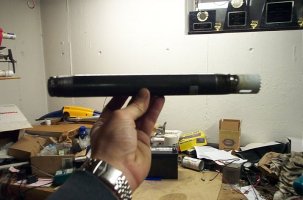Hello All,
Well, my E38 is on the hard and the keel bolt/keel rebedding project is underway. So far the 12 nuts and washers have been removed but the keel will not drop. The yard will try again on Thursday and I have asked that it sit over the weekend in the Travelift hoping gravity will do the job.
There is corrosion on 4-5 of the keel bolts where the threads are missing right where the nuts engage or directly below. There is one with diameter reduced by about 25%. I couldn't see very well as it was night and cold too. When the keel comes off and I can see more then I can make a decision on what to do.
I have been in contact with Don Huseman, apparently the former owner of Keelco? Since the bolts in my E38 are marked Keelco I assume he made the keel. He claims that it is possible to melt out the damaged bolts and weld in new ones. Seems like a reasonable idea if not dangerous and requiring some skill. He will come to my location and do this work if needed. Any feedback on this would be appreciated.
I am prepared entertain all repair possibilities that will return my boat to its original condition, or better. I am not interested in sistering, or adding extra keel bolts. The TAFG grid is cramped enough and I really don't want surveyors asking questions when they see extra bolts at resale time.
So far the options for repair are:
1 Sleeve the damaged bolts and use spacers, etc.
2 Drill out bolts and install new threaded rod and toggles through keel
3 Burn out old bolts, weld in new.
4 Cut off and weld on new material?
5 Clean thoroughly, weld up damaged area, recut threads?
6 Pull out credit card and order new keel from Mars. (really)
If anyone knows pros/cons/cost of any or all of these..... I have done the searches and read the threads already, more details if possible.
Comments and input welcome, TIA
RT
Well, my E38 is on the hard and the keel bolt/keel rebedding project is underway. So far the 12 nuts and washers have been removed but the keel will not drop. The yard will try again on Thursday and I have asked that it sit over the weekend in the Travelift hoping gravity will do the job.
There is corrosion on 4-5 of the keel bolts where the threads are missing right where the nuts engage or directly below. There is one with diameter reduced by about 25%. I couldn't see very well as it was night and cold too. When the keel comes off and I can see more then I can make a decision on what to do.
I have been in contact with Don Huseman, apparently the former owner of Keelco? Since the bolts in my E38 are marked Keelco I assume he made the keel. He claims that it is possible to melt out the damaged bolts and weld in new ones. Seems like a reasonable idea if not dangerous and requiring some skill. He will come to my location and do this work if needed. Any feedback on this would be appreciated.
I am prepared entertain all repair possibilities that will return my boat to its original condition, or better. I am not interested in sistering, or adding extra keel bolts. The TAFG grid is cramped enough and I really don't want surveyors asking questions when they see extra bolts at resale time.
So far the options for repair are:
1 Sleeve the damaged bolts and use spacers, etc.
2 Drill out bolts and install new threaded rod and toggles through keel
3 Burn out old bolts, weld in new.
4 Cut off and weld on new material?
5 Clean thoroughly, weld up damaged area, recut threads?
6 Pull out credit card and order new keel from Mars. (really)
If anyone knows pros/cons/cost of any or all of these..... I have done the searches and read the threads already, more details if possible.
Comments and input welcome, TIA
RT


